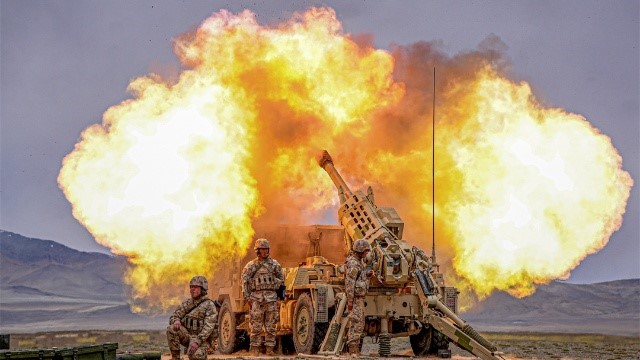Just as the industrial revolution changed the world’ economy and the way wars were fought hundreds of years ago, space technology is altering the way humanity works, prospers, and, yes, fights wars.
If America is to survive and thrive, it must successfully utilize space. The National Space Intelligence Center and the National Air and Space Intelligence Center have produced a landmark report, “Competing in Space.” We reproduce key portions of that vital work.
Every day, billions of people rely on spacecraft orbiting hundreds and thousands of miles above Earth. Complex satellite constellations support the world’s finances, transportation, and agriculture, providing essential services that transcend international borders and touch the lives of virtually every person on Earth. Major disruptions to satellite services would cause significant, perhaps irreparable, damage to 21st century life. Space systems have transformed international competition and conflict. Over 80 countries own satellites and many of these countries consider access to space systems and services as important contributors to their national security and military power projection. The U.S.’s key competitors, China and Russia, both operate hundreds of space systems to strengthen warfighting capabilities, boost spheres of influence, and position themselves as leaders in the international space community. At the same time, both of these competitors are developing counterspace capabilities capable of degrading or destroying space systems critical to civilian infrastructure and military operations. Space promises humanity boundless capabilities, resources, and achievements. However, the world’s increasing space use has made the inherent risks and vulnerabilities apparent. This publication identifies those capabilities, trends, and dangers that constitute the present and future of our space-integrated lives.
Everyday Life
Space services are key enablers of industry, critical infrastructure, and international trade. Navigation satellites provide precise timing references for banks, stock markets, and national power grids, as well as positioning data for cell phones to operate and for trucks, airplanes, and cargo ships to find their way around the world. Remote sensing satellites enable timely warning and monitoring of weather events and natural disasters, and perform mapping and tracking functions for agriculture, environmental protection, resource management, and city planning. Communications satellites supplement terrestrial communications networks and offer people, particularly those in remote or conflict regions, access to telephone, television, and broadband internet.
NATIONAL SECURITY
Space services are also key enablers for national defense and military operations. Remote sensing satellites allow tracking and monitoring of adversary installations and movement of forces. Navigation satellite constellations, like the U.S.’s Global Positioning System (GPS), provide critical positioning, navigation, and timing data to improve the effectiveness of guided munitions and deploying forces worldwide. Communications and relay satellites securely transmit data to military forces, particularly in remote regions inaccessible by traditional terrestrial communications. Ballistic missile early warning satellites serve as the initial alarm for detecting ballistic missile launches and are a critical part of national missile defense architectures.
Space Operations
Several of the world’s advanced spacefaring nations operate launch vehicles, satellites, and ground-based support infrastructure. Our key competitors, China and Russia, have developed launch vehicles capable of reaching all orbits, substantial satellite constellations for remote sensing, navigation, and communications, and networks of ground sites to launch, control, and support their spacecraft.
COMPETITORS’ SPACE PARTNERSHIPS
China and Russia offer launch and satellite services to other countries. Partnerships like these offer non-spacefaring nations the benefits of space use without the expense of developing their own space support infrastructure. China particularly incentivizes its space partnerships by offering technical exchanges, satellite services, and even production of complete satellites at little initial cost. Beyond, or in lieu of, monetary payments, China and Russia can use these opportunities to garner geopolitical influence and bolster scientific prestige. As part of broader efforts to improve military force capabilities and technological innovation, China and Russia are increasingly integrating civilian, commercial, and academic space expertise into military programs. This was evident in early 2023 when the U.S. issued sanctions and export controls against Chinese and Russia companies for providing satellite imagery support to Russian military operations in Ukraine. Both countries also pursue collaboration with academic and civil organizations abroad to enhance scientific research and expand space surveillance capabilities outside their respective borders.
SPACE GROWTH
Since the first edition of “Competing in Space,” the number of active satellites in space has more than tripled, from 1,880 to 7,096 at the end of 2022. While plans for massive mega-constellations made up of hundreds or thousands of satellites cause projections to vary widely, some estimates indicate the number of satellites in orbit may exceed the tens or even hundreds of thousands by 2032. Increasing commercial availability of launch services and production of small satellites that are cheaper, less complex, and faster to develop are propelling this growth. These factors enable some launch providers to send over a hundred satellites into low Earth orbit on one launch vehicle; for instance, India launched a foreign record of 104 satellites at once in early 2017.
The Report Continues Tomorrow
Photo: NASA









